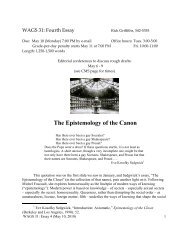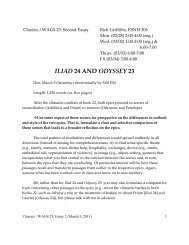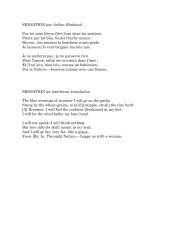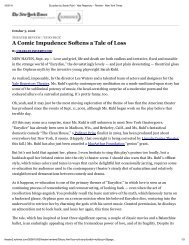Manet's Olympia: The Figuration of Scandal
Manet's Olympia: The Figuration of Scandal
Manet's Olympia: The Figuration of Scandal
You also want an ePaper? Increase the reach of your titles
YUMPU automatically turns print PDFs into web optimized ePapers that Google loves.
Bernheimer * <strong>The</strong> <strong>Figuration</strong> <strong>of</strong> <strong>Scandal</strong> 267<br />
quently assumed by upper-class prostitutes. <strong>The</strong> younger Dumas gave<br />
the name Olympe to the heartless, mercenary courtesan, modern rival<br />
<strong>of</strong> the sentimental Marguerite, in La dame aux camelias, and the name<br />
was used frequently in the popular literature and drama <strong>of</strong> the 1860s<br />
to designate a calculating cocotte. <strong>The</strong> Italianate form <strong>of</strong> the name,<br />
<strong>Olympia</strong>, was less current. To <strong>The</strong>ophile Gautier (cited in Clark 1985:<br />
285), it brought to mind the infamous Roman courtesan <strong>of</strong> the Renaissance,<br />
Donna Olimpia Maldachini, beautiful sister-in-law, sordid<br />
paramour, and intriguing manipulator <strong>of</strong> Pope Innocent X. <strong>The</strong> name<br />
was associated with power wielded more independently, but again in<br />
a sexually controlling way, when given to a beautiful pagan queen in<br />
the grand opera Herculaneum, first performed in 1859 and still playing<br />
to full houses in 1863, the year in which Manet created his painting.3<br />
Although Queen <strong>Olympia</strong> is defeated in her appointed mission<br />
to halt the spread <strong>of</strong> Christianity by seducing, when necessary, the<br />
adepts <strong>of</strong> the new religion, she is a strong-willed, defiant, regal figure,<br />
not an egotistic, scheming demi-mondaine. But the most suggestive<br />
hypothetical reference <strong>of</strong> the name Manet chose, precisely because it<br />
thematizes the play <strong>of</strong> indeterminacy, is to the mechanical doll <strong>Olympia</strong><br />
in E. T. A. H<strong>of</strong>fmann's story "<strong>The</strong> Sandman," the text on which<br />
Freud based his analysis <strong>of</strong> the uncanny. <strong>The</strong> captivating doll is at<br />
once human and nonhuman, alive and dead, whole yet dismemberable,<br />
female yet not female. It is associated, in obvious ways, with<br />
childhood, whence originate, according to Freud, the primitive beliefs<br />
whose recurrence after repression creates the unsettling effect <strong>of</strong><br />
uncanniness.<br />
What repressed primitive belief might <strong>Manet's</strong> painting be felt to<br />
evoke? In his mocking commentary on <strong>Olympia</strong>, one <strong>of</strong> the early hack<br />
critics <strong>of</strong> the 1865 salon made a connection that may provide us with<br />
a clue to this question. <strong>The</strong> journalist denounces <strong>Olympia</strong> as "some<br />
form or other blown up like a grotesque in india rubber" and goes<br />
on to call her "a sort <strong>of</strong> monkey mocking the pose and the movement<br />
<strong>of</strong> the arm <strong>of</strong> Titian's Venus, with a hand shamelessly flexed" (ibid.:<br />
288). Viewing <strong>Olympia</strong> as a kind <strong>of</strong> doll, this writer is led to evoke<br />
the placement and articulation <strong>of</strong> the hand covering her sex. He does<br />
so by alluding to Titian's Urbino Venus, a reference that is now a<br />
commonplace <strong>of</strong> art history but that he was the only critic to notice<br />
3. This context for <strong>Manet's</strong> use <strong>of</strong> the name is discussed by Sharon Flescher<br />
(1985). Flescher also identifies a self-determined <strong>Olympia</strong> in an unpublished play<br />
by <strong>Manet's</strong> friend Zacharie Astruc, whose poem "<strong>Olympia</strong>, la fille des iles" was<br />
printed in the salon catalog and much derided by the critics, especially for its last<br />
line, "L'augustejeune fille en qui la flamme veille." Astruc has <strong>of</strong>ten been credited<br />
with giving the painting its title, although this cannot be proven. See Reff 1977:<br />
111-13 for further discussion <strong>of</strong> the name.

















